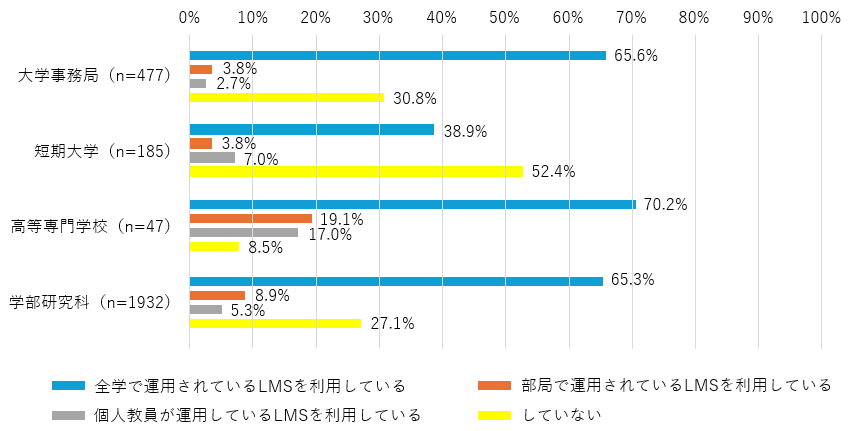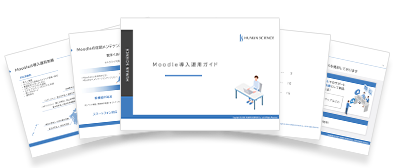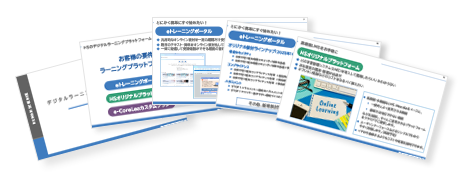2024.08.08
What are the methods of ICT utilization education in universities? An explanation of usage methods with examples!

The use of ICT in educational institutions has become active. In particular, the experience of the COVID-19 pandemic has accelerated this movement even further. Many universities are already advancing education utilizing ICT, but what further applications can be made? In this blog, we will introduce examples and key points of ICT utilization in universities.
1. Advancing ICT Utilization in Universities

What is ICT?
"ICT" stands for "Information and Communication Technology." In Japanese, it translates to "Information and Communication Technology." It refers to the use of information and communication technology to connect people and things. We communicate with others using the internet, computers, and smartphones. For example, we send messages to friends on social media or hold online meetings using web conferencing apps. These are concrete examples of utilizing ICT.
The term that has been used for a long time is "IT" (Information Technology). This refers to computers and infrastructure, and is often used to indicate the performance of the computer itself, such as the resolution of a PC, HDD capacity, and internet speed. Since then, various technologies that did not exist when the internet first appeared have emerged, such as "IoT (Internet of Things)", "DX (Digital Transformation)", and "AI (Artificial Intelligence)". Due to the evolution of these technologies, the term "ICT" has come to be used, which includes the meaning of information and communication technology, making "IT" a more appropriate term.
Advancement of ICT Utilization in Universities
The situation of ICT utilization in universities can be seen from several survey results.
・Increased Use of LMS
Learning Management Systems (LMS) are being utilized in many universities. Please take a look at the survey results here.
Regarding the usage and operation status of the LMS, we asked the question, "Are you using a Learning Management System (LMS)?" and requested multiple responses to the options: "Using the LMS operated by the entire university," "Using the LMS operated by a department," "Using the LMS operated by individual faculty members," and "Not using it." The percentage of those who have implemented an LMS at the university office (4-year universities) was 69.2%. This indicates a high rate of LMS usage.

※
"Survey Research Report on the Utilization of ICT in Higher Education Institutions (2nd Edition) July 2020" (Published by AXIES University ICT Promotion Council)
was used as the basis for this.
・The introduction of video conferencing tools is also progressing
Many universities are adopting tools like Zoom and Teams for online classes. The survey results for video conferencing tools are as follows.
In conjunction with the implementation of online classes, a video conferencing service was introduced in the 2020 academic year. Therefore, in the 2020 survey, we asked, "Is the video conferencing service contracted and implemented across the entire university?" As a result, it was found that 89.1% of organizations have implemented it university-wide. The implementation rates by university size are shown in Table 3. The sizes are as follows:
Group A: 10,001 or more
Group B: 5,001 to 10,000
Group C: 3,001 to 5,000
Group D: 1,001 to 3,000
Group E: 1,000 or fewer
Groups A to D are all implemented at over 90%. It can be seen that most universities have adopted them.

※
"Current Status and Changes Over Time of ICT Environment Implementation by Scale in Universities"
(2021, AXIES University ICT Promotion Council)
was used as the basis for this creation.
・The introduction of academic management, learning support, and student support tools is also progressing
The above report includes survey results indicating that various tools are being used in the ICT environment as follows.
ICT Environment Related to Infrastructure: "Campus Wireless LAN", "Email System", "Website Management System"
ICT Environment Related to Academic Affairs: "Syllabus Publication", "Admission Procedure System", "Course Management System", "Student Information System"
ICT Environment Related to Learning Support: "Lecture Recording System", "Public Access to Lecture Materials and Videos", "Creation and Provision of E-Textbooks"
ICT Environment Related to Student Support: "Services for Prospective Students", "Establishment of Help Desk"
The fact that such tools are being implemented in many universities indicates that the use of ICT is advancing in higher education.
2. How to Utilize ICT in University Education

It has been found that the use of ICT is advancing in universities. So, how is ICT actually being utilized in education at universities? We will introduce the methods of utilization.
First, let's talk about the provision of e-learning courses. Here are four examples where universities have built websites centered around specific themes to publish and disseminate information.
・Hokkaido University OpenCourseWare
This website publicly shares lecture-related information such as video materials and lecture materials from university lectures and open courses. You can browse content that suits your needs using the keyword search function and the list display function by field. It can be used not only for self-study but also in educational settings.
Through the public release of video materials and lecture materials, we actively promote the knowledge and appeal of university education both domestically and internationally, and we are also actively engaged in new initiatives utilizing the internet.
・Waseda University Extension Center
The Waseda University Extension Center serves as an institution to broadly open the research and educational functions of Waseda University to society, as indicated by the meaning of "Extension" (i.e., expansion and openness). Since its founding, Waseda University has promoted lifelong learning through the publication of "lecture notes" aimed at external students and the hosting of "traveling lectures" in various locations. The Extension Center was established in 1981, inheriting this tradition. It offers open courses conducted by Waseda University professors, emeritus professors, and leading scholars and practitioners to all those eager to learn. In 1988, the general term for open courses was changed to "Waseda University Open College," and a unique credit system was introduced. Additionally, in 2014, the Nakano campus (Tokyo, Nakano Ward) was opened, striving to enhance lifelong learning with a two-campus system.
・Affiliated School Research Presentation (Tsukuba University)
The Education Bureau of Tsukuba University Affiliated Schools introduces the research and educational practices of each affiliated school through on-demand distribution. By sharing and disseminating these results, we aim to deepen the understanding of the educational research activities of the affiliated schools. Additionally, we are strengthening collaboration among affiliated schools, the university, and related organizations to ensure that future educational research becomes even more substantial.
・Future Outlook Seminar 2020
Osaka Seikei University has been conducting a public course titled "Future Outlook Seminar 2020" since the 2020 academic year, aimed at individuals working at the forefront of companies and organizations, as well as students, to equip them with the wisdom to accurately discern global trends and succeed in global competition through a total of 8 sessions.
Next, we will introduce three examples of utilizing ICT in classes. Many universities are actively incorporating ICT technology with various creative approaches.
・Utilizing Online Materials and LMS (Learning Management System) in Clinical Pharmacy Practice
This is a case study regarding the Clinical Pharmacy Practice at a certain university. In this course, practical training in dispensing is conducted, but it is not something that can be mastered in a single class, and there may be instances where not all students can observe the instructor's techniques. Therefore, we aim for effective learning by having students review online materials in advance, learn during the lecture, and then revisit the online materials for any areas that need further understanding. With online materials available, students can study repeatedly outside of class.
This online teaching material is distributed from the LMS. By utilizing the LMS, we manage attendance, distribute materials, conduct tests, submit reports, carry out surveys, and manage grades. We make use of many LMS features to obtain the information necessary for credit certification. There has been a change where students have started to meet report submission deadlines by using the LMS. Previously, there were times when reports could not be submitted because the teacher was unavailable, but with the LMS, students can submit at any time. Additionally, using the LMS allows multiple instructors to collaborate on evaluating reports, making it very effective.
To participate in the internship, it is necessary to pass the national standardized OSCE exam led by the Pharmaceutical Common Examination Center, but it seems that there have been no failures in the past three years. It is felt that learning through video materials and the use of LMS is very effective.
・Connect to Zoom using your own PC or smartphone
Many classrooms at a certain university are long and narrow, so to make the screen more visible, a ceiling-mounted sub-monitor has been installed in the middle of the classroom. However, there is a limit to the size of the sub-monitor, which has led to the problem that students sitting at the back of the classroom have difficulty seeing the blackboard or screen. We thought that this issue could be resolved by utilizing Zoom, and we introduced a license that can be used by all faculty and students. Currently, students can connect to Zoom using their own smartphones or PCs, allowing them to view the materials displayed on the screen without any issues, even when seated at the back.
Online Examination (IBT) Using Moodle and Queue-it
An online exam (IBT: Internet Based Testing) was conducted using Queue-it (a waiting room feature provided by Queue-it) at a certain university.
>Moodle and IBT - Conducting Online Exams Using Waiting Room Functionality -
At this university, we have been conducting classes using an online learning management system based on Moodle, which was implemented school-wide before the pandemic. However, final exams required students to come to campus to take the tests. After careful consideration within the university, it was decided to conduct the exams online. One concern was that when many students started the exam simultaneously, the system could become overloaded, making it difficult for some students to connect and start the exam on time. Therefore, we prepared the Moodle server with an estimated number of simultaneous accesses, but to avoid server downtime in case of higher-than-expected usage, we utilized the Queue-it waiting room feature.
When the number of accesses exceeds the limit, students will be directed to the waiting room (waiting screen) and will be guided to the online exam on a first-come, first-served basis. This allowed the final exam, conducted online for the first time, to be completed without confusion. Situations such as "unable to access" or "server crash" were avoided. After the exam, logs of actual access numbers and waiting times can be obtained, allowing the university to check usage and prepare for the next final exam.
・Share screens with high-definition 4K images and videos
At a certain university, there is a seminar room on campus. In this seminar room, programming practices and practical skills learning take place, with many computers lined up, allowing students to receive information from lectures and instructors. Furthermore, the environment is well-suited for information sharing and group work. Instructors can smoothly share their computer screens with students, facilitating group work.
"Pair programming" is a method of creating programs together with two people. One person is responsible for keyboard input and mouse operations, while the other generates ideas, points out mistakes, and asks questions. Using this method can help you acquire the skills to write high-quality code and reduce production time. Additionally, by changing partners during class, you can gain new ideas and contribute to the overall skill improvement of the class.
At this university, we use dedicated hardware to compress images for real-time streaming. This hardware supports 4K high-definition images and is a system for image transfer that can be used in CALL classrooms, active learning classrooms, and lecture halls. The compressed streaming results in minimal delay, allowing information to be shared in real-time.
The instructor's computer screen can be displayed next to the students, allowing them to learn programming together while observing the instructor's work. For example, in classes that control electronic circuits, the instructor explains the source code while demonstrating the operation of the circuit. This image distribution system enables clear lessons for the students.
3. Key Points of ICT Utilization in University Education

Here are three points that will help you utilize ICT in higher education.
Point 1: Select easy-to-understand and user-friendly tools, and ensure operational support
As an ICT tool, there is an online meeting system. A representative tool, "Zoom," is used by many people. Earlier, I introduced how to "connect to Zoom on your PC or smartphone," but it seems that there was hardly any need to explain how to use Zoom when it was introduced. Preparing manuals to explain operations and how much the inquiry support would be a burden are important factors for tool selection.
Another ICT tool that is commonly used is the LMS (Learning Management System). The most widely used LMS in universities across Japan is "Moodle." Since Moodle is open-source software, it has the significant advantage of not being dependent on a specific vendor. When using a product from a specific vendor, if you want to change vendors or if support for that product is discontinued, you will need to search for a new LMS and rebuild everything from scratch. However, in the case of Moodle, you can request operational support from another vendor while maintaining the current state of use.
>What are the benefits of the open-source LMS 'Moodle'?
Point 2: Enhance Student Motivation
How can we utilize ICT to enhance students' motivation to learn? "Motivation to learn" refers to having one's own willingness and interest when engaging in learning. Motivation to learn can be divided into intrinsic motivation (the motivation to do something from within) and extrinsic motivation (the motivation driven by external factors).
For example, if a student fails to earn credits in a required course, external factors (the obligation to earn credits) become a motivation. However, this is something that must be done, and it is not necessarily what the student truly wants to do.
To enhance learning motivation, the ARCS model is helpful. The ARCS model states that the learner's Attention, Relevance, Confidence, and Satisfaction are important. By utilizing these elements, we can expect to improve learning motivation. It involves using ICT to draw out learners' interests, convey the significance of learning, build their confidence, and create a sense of satisfaction.
・Attention
Incorporate elements that can capture the learners' interest. It is important to avoid boring content and make learners feel, "This seems interesting."
・Relevance
It is important that the learning objectives and tasks are relevant to the learners. Let's ensure that learners can actively engage towards their growth and goals.
・Confidence
Let's allow learners to accumulate successful experiences and build their confidence. It is important to choose materials that make them feel that their success is due to their own efforts and to instill the belief that "if you try, you can do it."
・Satisfaction
Let's make sure not to waste the results of our learning. The goal is to praise and recognize learners who have achieved their goals, provide fair evaluations, and make them feel, "I'm glad I did it."
Point 3: Recognize that ICT is merely a tool
ICT is a tool used in educational settings. However, to maximize its effectiveness, the teaching skills of educators are essential. When using ICT, educators need to consider the following.
・Selection and Utilization of Teaching Materials
Teaching materials refer to textbooks, handouts, and online resources used in classes. When using ICT, it is important for teachers to choose the right materials. They select materials that align with learning objectives and make efforts to engage students' interest.
・Lesson Planning and Design
Lesson planning involves considering the flow and content of the lessons. When conducting lessons using ICT, teachers must take into account the needs and learning styles of the learners. They design when and how to use ICT.
・Support for Learners
In a learning environment using ICT, there is a role to support students in using ICT appropriately. Teachers teach students how to use ICT and provide support by answering questions.
・Evaluation and Feedback
When assessing tasks and evaluations using ICT, teachers conduct fair and appropriate evaluations. They also provide feedback to students to enhance the quality of learning.
ICT is a useful tool in the educational field, but it is important to recognize that the teaching skills of educators are an essential element for effective utilization.
4. Summary
The use of ICT in educational institutions is advancing, but simply utilizing ICT does not necessarily improve the quality of education. It is essential to thoroughly consider in what situations and how it will be used, and what effects can be expected as a result. Knowledge-hungry children and young people are already mastering ICT to gain a wealth of knowledge and create new things. This trend is expected to accelerate even further in the future. I hope this blog will be of assistance to those who are already active in the educational field using ICT.
Human Science Co., Ltd. fully supports the use of ICT in educational institutions and companies. We provide comprehensive assistance from teaching material production to the introduction and operation of LMS. Please feel free to contact us.
>Moodle Implementation Support and Operation
>e-Learning Material Production
>e-Learning Material Translation (Multilingual Support, Localization)
Moodle Implementation and Operation Guide

We explain the process of introducing and operating Moodle.
For the introduction and operation of Moodle, please leave it to Human Science, the official partner. We also introduce many achievements in Moodle implementation support.
Projects: Over 866
Companies, Schools, Organizations: Over 80 cases
Moodle Related Information
- 2025.10.29
- [Moodle Manual ⑤] 2025 Edition|Support Staff Explain How to Set Up and Utilize Groups/Groupings!
- 2025.10.28
- Can You Obtain Qualifications Through e-Learning? Examples of Qualifications and Their Benefits












